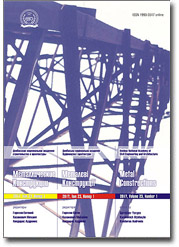Methodology of Experimental Research of Steel Element and Concrete Working Together on the Surface of their Contact
Abstract: The article presents a methodology for conducting static tests of a concrete prism made of concrete of class B15 to study the adhesion of concrete on a flat surface of a steel element. To conduct experimental studies, an installation consisting of two metal plates with dimensions of 500×100×10 mm was created. Concrete prisms are placed between these plates, which are compressed by a hydraulic press. The concrete sample is installed on a metal square slab with dimensions of 100×100 mm. The load on this structure is transmitted through a circular metal plate with a diameter of Ø200 mm to a metal cylinder with dimensions of 135×50 mm hydraulic jack GD-20, with a load capacity of 20 t. Horizontal deformations of the concrete prism along its length are recorded by an ICH-10 clock type indicator with an entry in the test log. The purpose of the tests was to study longitudinal horizontal shear deformations along the concrete-steel contact, depending on the level of compression of concrete.
Keywords: stress-strain state (VAT), experimental model, pipe-concrete (TB) element, hydraulic press, concrete prisms, chamfer for cylinder, concrete adhesion, steel shell, coefficient of transverse deformation.
Pages: 217-225.
For citation:
For citation: Vasylev, V. N.; Anishchenkov, V. M.; Boyko, M. M. Methodology of Experimental Research of Steel Element and Concrete Working Together on the Surface of their Contact. – Text : electronic. – In: <em>Metal Constructions</em>. – 2021. – Vol. 27, N 4. – Р. 217-225. – URL: https://donnasa.ru/publish_house/journals/mk/2021-4/03_vasylev_anishenkov_boyko.pdf (date of access: 04.04.2025). – ISSN 1993-3517.

Vol. 27, N 4 (2021)
Journal: Metal Constructions
Publish house: Donbas National Academy of Civil Engineering and Architecture
Journal: Metal Constructions
Publish house: Donbas National Academy of Civil Engineering and Architecture
